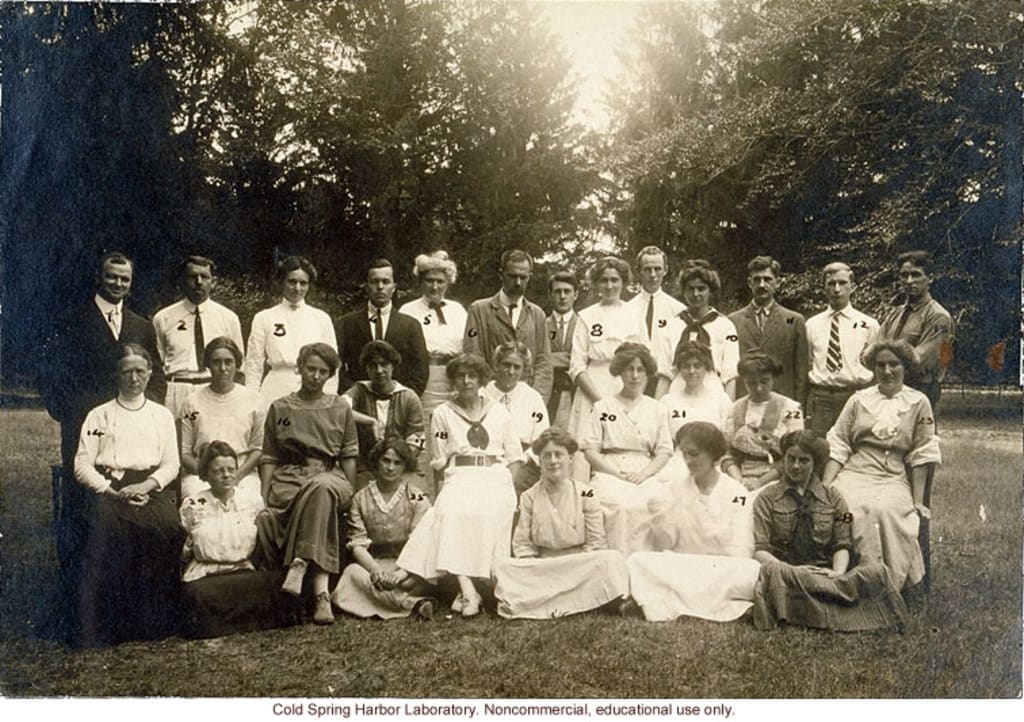Eugenics in the United States
A Brief History

During the Progressive Era, between 1896 to 1927, there was an increase in the interest in eugenics within the United States. During this time people strove to try to solve various societal problems including poverty, health issues, and immigration. Eugenic enthusiasts attempted to link these social and economic problems to individuals deemed “undesirable”. This segregation between “normal” people and “undesirables” included anyone associated with society’s problems and were often looked at as the cause of them. They were considered mentally deficient or “feeble-minded”.
The ability to be considered “feeble-minded” was a broad definition that often-included people outside of society's perceived norm. “In the late nineteenth and early twentieth centuries, “feeble-mindedness” was a kind of catchall term for people who were abnormally “slow,” who could not care for themselves, or who could not compete on equal terms in society. Both in the popular imagination and in elite opinion…feeble-minded persons were also considered to be inclined towards crime and vice.” They were believed to have bad genes passed on to the next generation and could include the poor, immigrants, criminals, minorities, and anyone else who did not fit into middle-class society. Eugenicists attempted to get rid of these vices and focus on promoting societies ideals with what they considered to be superior genes. In order to achieve this, they focused on researching families and genes in order to prove a clear difference between people who were “feeble-minded” and show that these negative traits were trackable genes passed down in “degenerate” families. Eugenicists pushed for change on multiple fronts, from promoting legislation to encourage detention and eventually sterilization of the “feeble-minded”, to public outreach, promoting healthy families through better baby and family contests.
The Eugenics Record Office was created in 1910 in Cold Spring Harbor, Long Island, and was often at the center of eugenics research in the United States, and one of the reasons eugenics took off in the United States. Benefactors of the ERO included Mary Harriman, the wife of E. H. Harriman, a railroad tycoon, John D. Rockefeller Jr. and Dr. John Harvey Kellogg. “The ERO became a meeting place for eugenicists, a repository for eugenics records, a clearinghouse for eugenics information and propaganda, a plat form from which popular eugenic campaigns could be launched, and a home for several eugenical publications.” The ERO had a form that created a standardized measurement for family research such as a family’s diet and political ties, which would eventually be used in contests hosted to find the family with the “best genes”. While there were other organizations and groups that were interested in eugenics, the ERO was fully-funded by benefactors that allowed them to have a paid staff. The ERO had a summer program to train field workers to be experts in collecting research on families, as of 1916 training more than 100 workers. They conducted a variety of research which included records of family trees and research in the field of families in various rural areas.
They would create diagrams of family trees in order to trace certain negative traits over generation, like Mendel’s research on pea plants. “Using pedigree analyses as the data from which possible Mendelian patterns of inheritance could be deduced, eugenicists in the United States began to study a wide variety of physical, mental, and moral traits in humans.” Researchers would go to rural areas and trace family trees through a variety of methods including observation and heresy producing results often with preconceived biases. Estabrook and Davenport, the director of the ERO, researched and created a family tree and genetic trace of the Nam family in New York. “Included in the evidence these authors presented for Nam backwardness and degeneracy were rude dwellings, hunting and fishing livelihoods, basketmaking, wandering, clannishness, reciprocity, and intermarriage between close relatives, among other things.” These practices, instead of being attributed to the Native American culture within the Nam family were instead considered proof that this family were simple minded and did not fit into the standard view of American society. In order to collect their research, they traced the family trees and went to individuals for common gossip in order to collect data on the individuals they were researching. Even measurements were not done properly, using guesswork for height on both those deceased and those still alive.
In the case of the research done by Estabrook and Davenport into the Nam family, they concluded that the children of these families should be separated during their child-bearing years in order to prevent any future children from carrying “bad traits” and poisoning the rest of society. For example, behaviors such as promiscuity or prostitution and alcoholism were considered genetic traits, defects that could be passed down to future generations. The separation of the “feeble-minded” from the rest of society in the attempt to prevent degenerative traits from being passed down eventually moved to the idea of sterilizing those deemed unqualified to bear children, by force if necessary.
Over the next few years states began to create laws based on sterilizing individuals deemed unworthy to reproduce. In 1916 Madison Grant wrote the book, The Passing of the Great Race, used by those interested in eugenics across the United States and world. Grant was an American lawyer who was involved in several eugenics’ groups, including the ERO who helped him with his publications. In it he asked for forced sterilization after assuming 10% of the United States public should not procreate. While not the beginning of the eugenics movement into forced sterilization it did help influence a wider audience into believing in the power of eugenics and taking away others’ voices.
In the beginning of the 1900’s many states began to enact laws involving sterilization in institutions such as mental hospitals where “feeble-minded” people were already segregated from the population. “Indiana enacted the first sterilization law in 1907, and within ten years fifteen more states had legalized eugenic sterilization.” While the law was temporarily deemed unconstitutional it eventually was reinstated. Michigan joined the other states in 1913 on a law that enforced the sterilization of mentally ill patients. This pattern would continue in other states who believed that the “feeble-minded” did not have a say in their own reproduction.
“Speaking for eight members of the Court, Justice Oliver Wendell Holmes, Jr., wrote that ‘it is better for all the world if, instead of waiting to execute degenerate offspring for crime or to let them starve for their imbecility, society can prevent those who are manifestly unfit from continuing their kind . . . Three generations of imbeciles are enough.’” This shows how the eugenic propaganda had spread to main-stream America, including how “bad” traits and genes were thought to be passed from one generation to the other and that it was better socially for both the public and that individual to stop it from continuing.
By the end of the Progressive Era, “the United States Supreme Court upheld Virginia’s compulsory sterilization law in Buck v. Bell (1927), seventeen states had sterilization laws. Five years later, the number had jumped to thirty.” These sterilizations took place in a variety of locations where the “feeble-minded” were kept. The location of forced sterilization was not limited during this time period to just mental institutions, but within prisons as well. “In the early 20th century, castration was endorsed by the eugenics movement and was performed on male sex offenders in the USA.”
While eugenicists promoted forced sterilization in order to weed out “bad traits” passed down, they also sought to promote desired traits and emphasize the importance of environment and genes by hosting contests. Better Baby contests were held in state fairs and promoted the idea of eugenics and a more desirable offspring by examining babies for traits that were considered desirable and declaring a winner.
Indiana began to hold Better Baby Contests in 1920 until 1932 at state fairs, which at the time were one of the most popular events. These contests were financially backed by nation-wide companies. “[In Indiana] patronage [came] from businesses such as the Hoosier Fence Company and the Weber Milk Company, and by fostering a competitive climate in which the winner received cash prizes and a trophy.” While there were many contests held at various state fairs throughout the United States, some got nationwide attention due to publication in the press. In 1914 the New York Times published an article that at the University Settlement’s second annual Better Baby Contest a child named Olga Cohen took first place, winning $25. In this article the focus is on both the looks of the baby, how much she weighed, that she had four teeth, and that she won despite being in a bad mood due to vaccinations. A similar spread in the New York Times in 1923 shows a photo of Robert J. Burfeind who was “voted the most perfect baby in the recent better baby contest held by the Philadelphia Lodge.” Neither article focused on the requirements for the contests, or what the judges were looking for, other than these babies had the best genes of the group.
Eventually interest in baby contests waned in favor of the heredity involved in the whole family, leading to a new type of contest, fitter families. “Like the baby contests, Fitter Family Contests had their roots in state fairs, alongside the judging of cattle.” Like the Better Baby Contests, Fitter Family Contests promoted the eugenics movement by awarding prizes for families who carried the best genes desired by mainstream society.
Works Cited
Allen, Garland E. "The Eugenics Record Office at Cold Spring Harbor, 1910-1940: An Essay in
Institutional History." Osiris (Bruges) 2, (1986): 225-264.
Amy, Jean-Jacques and Sam Rowlands. "Legalised Non-Consensual Sterilisation-Eugenics Put
into Practice before 1945, and the Aftermath. Part 1: USA, Japan, Canada and
Mexico." The European Journal of Contraception & Reproductive Health Care 23, no. 2
(2018): 121-129.
Bender, Daniel E. and ProQuest (Firm). American Abyss: Savagery and Civilization in the Age of
Industry. Ithaca: Cornell University Press, 2009.
Frost, Daniel. "Protection Against Eugenics: A Comparison of Two Jurisprudences." Journal of
Supreme Court History 42, no. 3 (2017): 275-294.
Jarvenpa, Robert. Declared Defective: Native Americans, Eugenics, and the Myth of Nam
Hollow. Lincoln: University of Nebraska Press, 2018.
Ladd-Taylor, Molly. Fixing the Poor: Eugenic Sterilization and Child Welfare in the Twentieth
Century. Baltimore: Johns Hopkins University Press, 2017.
Markel, Howard. The Kelloggs: The Battling Brothers of Battle Creek. First ed. New York:
Pantheon Books, 2017.
Model Babies Win Prizes: Final Examination Made in Contest at University Settlement." New
York Times (1857-1922), May 14, 1914. http://search.proquest.com.ezproxy.gvsu.edu/docview/97624220?accountid=39473.
"Photo Standalone 13 -- no Title." New York Times (1923-Current File), Jul 03, 1927.
http://search.proquest.com.ezproxy.gvsu.edu/docview/104118762?accountid=39473.
Stern, Alexandra Minna. "Making Better Babies: Public Health and Race Betterment in Indiana,
1920-1935." American Journal of Public Health 92, no. 5 (2002): 742-752.
About the Creator
Scarlett Callohan
Hi, I'm Scarlett!
When I'm not busy writing I'm drinking a large amount of coffee while reading or working on new recipes.
Thank you for all your support!
If you'd like kindle copies of some of my fiction pieces visit Amazon and search for me!






Comments
There are no comments for this story
Be the first to respond and start the conversation.